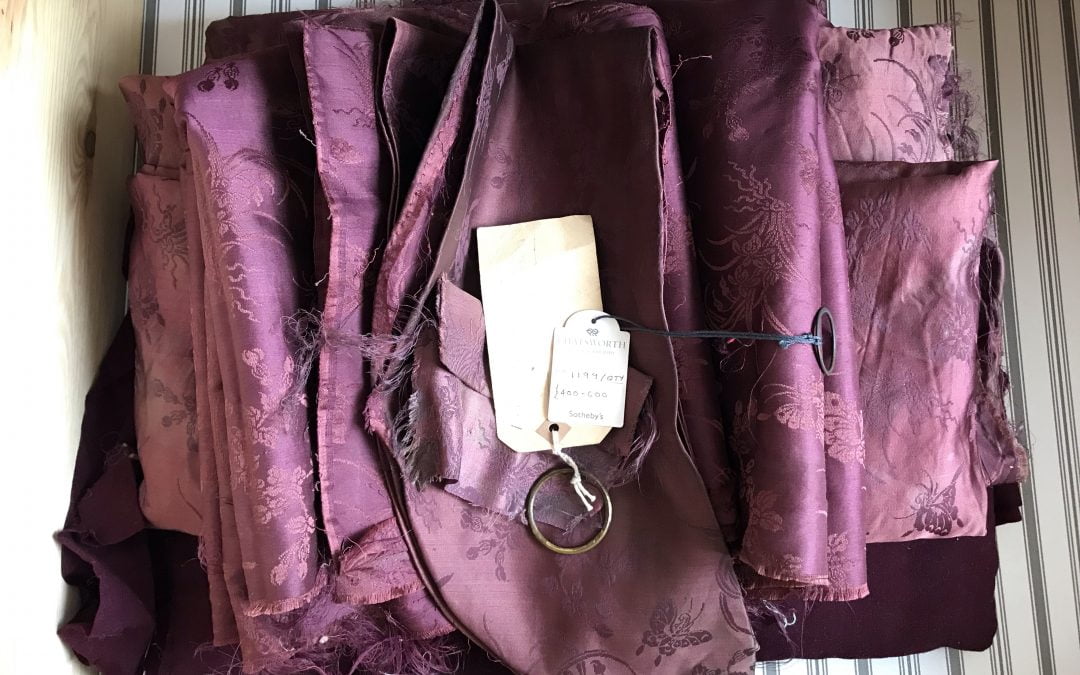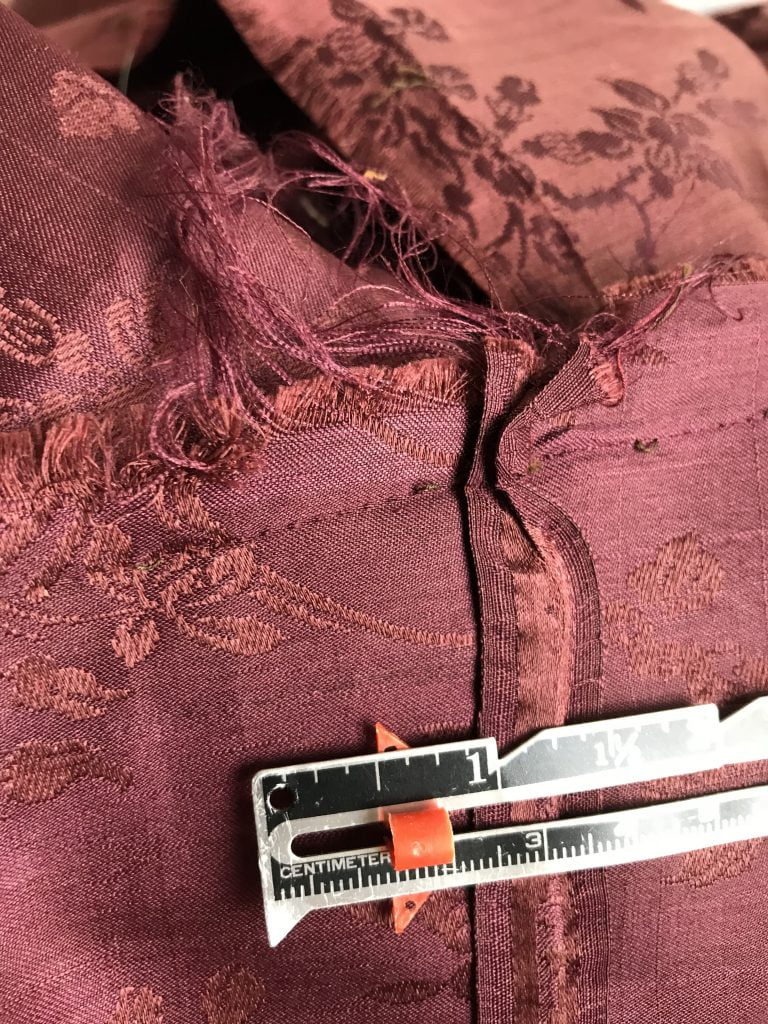Some projects spring fforth fully formed in the mind. The fabrics are there in your stash, and you drop everything and go to work immediately because you’re SO inspired. Two days later, behold the fruits of creativity unleashed!
Most projects, however, don’t go like this. Most are slower. Some stall and get re-started, and some projects take a decade or more to come together. Sometimes your ideas are way ahead of your ability to realise them… but worry not, patience might bring the resources you need.
I’ve become reluctant to get started on anything in recent times. Other responsibilities claim a lot of my spoons, and I avoid making promises any more – to you or to myself – because of this dress, which people still bring up from time to time.
Long story short, it’s a lot more involved – and a lot more expensive – than I anticipated in 2010. I’m currently building my business to a level where I have the money and the free time to make a $10k dress, but the dream has not died.
Sometimes your ideas are so big that you have to play the long game, that’s all.
Which brings me to this fabric.
This stunning silk damask was buried amongst a lot of curtains at the Chatsworth Attic Sale in October 2010. As the handwritten label states (below), it’s a curtain from 2 Carlton Gardens, London SW1 – an address occupied by the Duke of Devonshire from the 1920s to the 1940s. But the fabric is older… and there’s quite a lot of it……..
I’ve been planning a dress from this fabric since the day I bought it, but I’m sure you’ll understand the cutting anxiety on this one. The nerves we all feel when gingerly brandishing our fabric shears over a length of immaculate silk are somewhat heightened when the fabric itself, and not just the design, is genuinely Victorian. In short, I simply couldn’t screw this up.
I considered copying this fashion plate for a while – but I really got nervous at the thought of hacking up this gorgeous original silk for a vaguely approximate costume. I needed more information… and a lot more coaching. But sometimes playing the long game (or as some of us call it, “procrastination”) pays off, because I have those things now.
I’m sure you already know that I’m the founder of sewing community Foundations Revealed, and one of the innovations we’ve introduced in the last couple of years is a mentoring team of three of the best teachers I could find. Now our “Stitchlings” can get individual help with individual projects… and so can I. (*cough* See what I did there?)
So at long last, I can get some answers about this incredible fabric… how to use it, how NOT to use it, how to care for it, and most importantly, how not to trash it even though I might mean well at the time.
We are very fortunate indeed that Luca Costigliolo is our expert on historical dress at Foundations Revealed, as well as being a tutor at the School of Historical Dress, a co-author of the continuing Patterns of Fashion series, and a sought-after cutter for the entertainment industry. This is what he had to say about my fabric….
Firstly, it would be perfect for 1895 onwards (“not quite Art Nouveau, but going that way”), which makes me Very Happy, because I have an 1896 Worth gown in mind… more on that later. So we have a date. I can’t ruin it by choosing the wrong period now.
As for how to use it:
- Get the toile 100% perfect before cutting the final fabric. We agreed that you’d want a toile that was good enough to wear to the ball before risking cutting this stuff.
- He recommended underlining the skirt in silk taffeta, not tarlatan (as is common in the period) for “a nice crunch”. Dust frills in cotton organdy or the same taffeta used for the lining will protect the hem from wear.
- Use white or cream cotton sateen to interline the bodice. It moulds beautifully and will go very well with the satin weave of the fabric. Don’t get a darker colour that might transfer to my underwear when I sweat.
Care and feeding of the fabric:
- Roll the fabric, wrap in acid free tissue, and keep the dress in tissue too when it’s done.
- The red pigment is probably aniline dye, making it very light sensitive. It could fade very quickly indeed (in fact it has already begun to fade to a mysterious chartreuse in places, as you can see.) Don’t keep the fabric or the finished gown in daylight. Keep it in the dark whenever possible when not working on it. Don’t wear it on a sunny day (I’m thinking evening gowns only). He said that the fabric seems in good condition so I shouldn’t worry too much, but I should take care over its future.
- Use dress shields… because my sweat will discolour the fabric in a single evening.
So what am I going to make? I already stated that a fashion plate is not enough to hang this project on; I need details. And what better or more timely project than the 1896 Worth gown that just sold at auction? The wonderful Timothy Long shared tons of photographs and video on Instagram that will make this possible – including internal shots – and so, I think this fabric may have found its next form.
Now, to find the time and the courage to follow through.





I’m excited and daunted for you. I look forward to seeing your progress.
Thank you so much
Big fan , you inspire me in my practice
Australian artist
Instagram … jentrantorartist
Hit a moment where I felt it was all to much
Your videos gave me just the inspiration and commonsense ( f*& k you’re good)
From across the world, I’d like to let you know you make a difference
Thankful
From a fan down under
What a stunning fabric and gorgeous inspiration gown! I hope it’s all going well, it would be great to see the process of making the toiles as I’m an inexperienced sewer but very interested of the production of own of these amazing reproduction gowns. Maybe one day I’ll get some skills under my belt and be able to try one myself!
I went to chatsworth around 2008 or so… I’d always wanted to visit. It was fabulous! Never enough time to see it all… it happened to be at Christmas ! 😉
You’re so fortunate to acquire that! I look forward to watching you create …
You will have to go to the gardens and have photos done. Especially with the famous gravity fed huge fountain… 😉
Such a beautiful silk fabric shame to cut it.
Have you ever thought of trying to tracing its original maker. I wonder if it would be worth contacting the Gainsborough silk mill in Sudbury. They are an historic business, who wove for a lot of the stately homes. They are still weaving silk brocades to this day and may have your fabric design in their archives. There are also three other mills in Sudbury, Vanners and Stephen Walters, who are old established silk weavers, or Humphries who are newer, but weave for National Trust restoration projects.
It would make an interesting story.